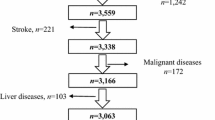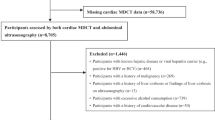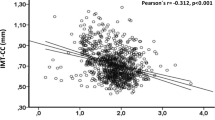Abstract
Background
Bilirubin is a product of heme oxygenase and an antioxidant per se. In selected cohorts and patient studies, bilirubin was associated with decreased risk for cardiovascular events. We aimed to determine the association of serum bilirubin with coronary artery calcification (CAC) and incident cardiovascular disease in the unselected general population.
Methods
Participants without prior coronary heart or liver disease were drawn from the population-based Heinz Nixdorf Recall study. CAC was measured from electron beam computed tomography and quantified using the Agatston method. Incident major cardiovascular events (coronary events, stroke, cardiovascular death) were assessed during follow-up. The association of bilirubin with CAC score and incident events was calculated using regression analysis.
Results
A total of 3,553 subjects (mean age 59.4 years, 44 % male) were included. Bilirubin was inversely correlated with CAC in men [estimated % change in (CAC + 1) per each gender-specific standard deviation of bilirubin [95 % confidence interval (CI): −6.1 (−11.6; −1.7) %, p = 0.032] but less so in women [−3.6 (−7.7; 0.2) %, p = 0.065], when adjusting for age only. With adjustment for traditional cardiovascular risk factors, the association was less pronounced [men: −2.5 (−7.5; 2.6) %, p = 0.35, women: −0.2 (−4.1; 3.5) %, p = 0.9]. Likewise, higher bilirubin by one standard deviation was associated with 19 % lower frequency of incident cardiovascular events in age- and gender-adjusted Cox regression analysis [hazard ratio (95 % CI): 0.81 (0.68; 0.96), p = 0.014]; this effect was slightly attenuated after adjustment for traditional cardiovascular risk factors [0.87 (0.73; 1.04), p = 0.13].
Conclusion
Our data from a general population suggest that a potential protective role of bilirubin in the atherosclerosis process is largely secondary to a more beneficial risk factor profile.

Similar content being viewed by others
References
Abraham NG, Kappas A (2008) Pharmacological and clinical aspects of heme oxygenase. Pharmacol Rev 60(1):79–127. doi:10.1124/pr.107.07104
Li Q, Guo Y, Ou Q, Wu WJ, Chen N, Zhu X, Tan W, Yuan F, Dawn B, Luo L, Hunt GN, Bolli R (2011) Gene transfer as a strategy to achieve permanent cardioprotection II: rAAV-mediated gene therapy with heme oxygenase-1 limits infarct size 1 year later without adverse functional consequences. Basic Res Cardiol 106(6):1367–1377. doi:10.1007/s00395-011-0208-6
Stocker R, Yamamoto Y, McDonagh AF, Glazer AN, Ames BN (1987) Bilirubin is an antioxidant of possible physiological importance. Science 235(4792):1043–1046
Grosser N, Erdmann K, Hemmerle A, Berndt G, Hinkelmann U, Smith G, Schroder H (2004) Rosuvastatin upregulates the antioxidant defense protein heme oxygenase-1. Biochem Biophys Res Commun 325(3):871–876. doi:10.1016/j.bbrc.2004.10.123
Kundur AR, Bulmer AC, Singh I (2013) Unconjugated bilirubin inhibits collagen induced platelet activation. Platelets. doi:10.3109/09537104.2013.764405
Kawamura K, Ishikawa K, Wada Y, Kimura S, Matsumoto H, Kohro T, Itabe H, Kodama T, Maruyama Y (2005) Bilirubin from heme oxygenase-1 attenuates vascular endothelial activation and dysfunction. Arterioscler Thromb Vasc Biol 25(1):155–160. doi:10.1161/01.ATV.0000148405.18071.6a
Jansen T, Hortmann M, Oelze M, Opitz B, Steven S, Schell R, Knorr M, Karbach S, Schuhmacher S, Wenzel P, Munzel T, Daiber A (2010) Conversion of biliverdin to bilirubin by biliverdin reductase contributes to endothelial cell protection by heme oxygenase-1-evidence for direct and indirect antioxidant actions of bilirubin. J Mol Cell Cardiol 49(2):186–195. doi:10.1016/j.yjmcc.2010.04.011
Dullaart RP, Kappelle PJ, de Vries R (2012) Lower carotid intima media thickness is predicted by higher serum bilirubin in both non-diabetic and Type 2 diabetic subjects. Clin Chim Acta 414:161–165. doi:10.1016/j.cca.2012.08.029
Zhang ZY, Bian LQ, Jae SY, Sung JD, Choi YH (2013) Serum total bilirubin is inversely associated with brachial-ankle pulse wave velocity in men with hypertension. Heart Vessel 28(4):453–460. doi:10.1007/s00380-012-0261-6
Zhang ZY, Bian LQ, Kim SJ, Zhou CC, Choi YH (2012) Inverse relation of total serum bilirubin to coronary artery calcification score detected by multidetector computed tomography in males. Clin Cardiol 35(5):301–306. doi:10.1002/clc.21964
Kronenberg F (2010) Association of bilirubin with cardiovascular outcomes: more hype than substance? Circ Cardiovasc Genet 3(4):308–310. doi:10.1161/CIRCGENETICS.110.957399
Horsfall LJ, Nazareth I, Petersen I (2012) Cardiovascular events as a function of serum bilirubin levels in a large, statin-treated cohort. Circulation 126(22):2556–2564. doi:10.1161/CIRCULATIONAHA.112.114066
Kim KM, Kim BT, Park SB, Cho DY, Je SH, Kim KN (2012) Serum total bilirubin concentration is inversely correlated with Framingham risk score in Koreans. Arch Med Res 43(4):288–293. doi:10.1016/j.arcmed.2012.05.003
McArdle PF, Whitcomb BW, Tanner K, Mitchell BD, Shuldiner AR, Parsa A (2012) Association between bilirubin and cardiovascular disease risk factors: using Mendelian randomization to assess causal inference. BMC Cardiovasc Disord 12:16. doi:10.1186/1471-2261-12-16
Stender S, Frikke-Schmidt R, Nordestgaard BG, Grande P, Tybjaerg-Hansen A (2013) Genetically elevated bilirubin and risk of ischaemic heart disease: three Mendelian randomization studies and a meta-analysis. J Intern Med 273(1):59–68. doi:10.1111/j.1365-2796.2012.02576.x
Schmermund A, Mohlenkamp S, Stang A, Gronemeyer D, Seibel R, Hirche H, Mann K, Siffert W, Lauterbach K, Siegrist J, Jockel KH, Erbel R (2002) Assessment of clinically silent atherosclerotic disease and established and novel risk factors for predicting myocardial infarction and cardiac death in healthy middle-aged subjects: rationale and design of the Heinz Nixdorf Recall Study. Am Heart J 144(2):212–218
Erbel R, Mohlenkamp S, Moebus S, Schmermund A, Lehmann N, Stang A, Dragano N, Gronemeyer D, Seibel R, Kalsch H, Brocker-Preuss M, Mann K, Siegrist J, Jockel KH (2010) Coronary risk stratification, discrimination, and reclassification improvement based on quantification of subclinical coronary atherosclerosis: the Heinz Nixdorf Recall study. J Am Coll Cardiol 56(17):1397–1406
Schmermund A, Lehmann N, Bielak LF, Yu P, Sheedy PF 2nd, Cassidy-Bushrow AE, Turner ST, Moebus S, Mohlenkamp S, Stang A, Mann K, Jockel KH, Erbel R, Peyser PA (2007) Comparison of subclinical coronary atherosclerosis and risk factors in unselected populations in Germany and US-America. Atherosclerosis 195(1):e207–e216
Moebus S, Stang A, Mohlenkamp S, Dragano N, Schmermund A, Slomiany U, Hoffmann B, Bauer M, Broecker-Preuss M, Mann K, Siegrist J, Erbel R, Jockel KH (2009) Association of impaired fasting glucose and coronary artery calcification as a marker of subclinical atherosclerosis in a population-based cohort-results of the Heinz Nixdorf Recall Study. Diabetologia 52(1):81–89
Jockel KH, Lehmann N, Jaeger BR, Moebus S, Mohlenkamp S, Schmermund A, Dragano N, Stang A, Gronemeyer D, Seibel R, Mann K, Volbracht L, Siegrist J, Erbel R (2009) Smoking cessation and subclinical atherosclerosis–results from the Heinz Nixdorf Recall Study. Atherosclerosis 203(1):221–227
Agatston AS, Janowitz WR, Hildner FJ, Zusmer NR, Viamonte M Jr, Detrano R (1990) Quantification of coronary artery calcium using ultrafast computed tomography. J Am Coll Cardiol 15(4):827–832
Sung KC, Shin J, Lim YH, Wild SH, Byrne CD (2013) Relation of conjugated bilirubin concentrations to the presence of coronary artery calcium. Am J Cardiol 112(12):1873–1879. doi:10.1016/j.amjcard.2013.08.018
Maruhashi T, Soga J, Fujimura N, Idei N, Mikami S, Iwamoto Y, Kajikawa M, Matsumoto T, Kihara Y, Chayama K, Noma K, Nakashima A, Tomiyama H, Takase B, Yamashina A, Higashi Y (2012) Hyperbilirubinemia, augmentation of endothelial function, and decrease in oxidative stress in Gilbert syndrome. Circulation 126(5):598–603. doi:10.1161/CIRCULATIONAHA.112.105775
Ajja R, Lee DC, Sui X, Church TS, Steven NB (2011) Usefulness of serum bilirubin and cardiorespiratory fitness as predictors of mortality in men. Am J Cardiol 108(10):1438–1442. doi:10.1016/j.amjcard.2011.06.067
Huang SS, Huang PH, Leu HB, Wu TC, Lin SJ, Chen JW (2010) Serum bilirubin predicts long-term clinical outcomes in patients with cardiac syndrome X. Heart 96(15):1227–1232. doi:10.1136/hrt.2009.192393
Ekblom K, Marklund SL, Johansson L, Osterman P, Hallmans G, Weinehall L, Wiklund PG, Hultdin J (2010) Bilirubin and UGT1A1*28 are not associated with lower risk for ischemic stroke in a prospective nested case-referent setting. Cerebrovasc Dis 30(6):590–596. doi:10.1159/000319778
Ekblom K, Marklund SL, Jansson JH, Osterman P, Hallmans G, Weinehall L, Hultdin J (2010) Plasma bilirubin and UGT1A1*28 are not protective factors against first-time myocardial infarction in a prospective, nested case-referent setting. Circ Cardiovasc Genet 3(4):340–347. doi:10.1161/CIRCGENETICS.109.861773
Acknowledgments
This work was supported by the Heinz Nixdorf Foundation Germany, the German Ministry of Education and Science (BMBF), and the German Research Council Assessment (Deutsche Forschungsgemeinschaft, DFG).
Conflict of interest
No conflicts of interest to declare.
Author information
Authors and Affiliations
Corresponding author
Rights and permissions
About this article
Cite this article
Mahabadi, A.A., Lehmann, N., Möhlenkamp, S. et al. Association of bilirubin with coronary artery calcification and cardiovascular events in the general population without known liver disease: the Heinz Nixdorf Recall study. Clin Res Cardiol 103, 647–653 (2014). https://doi.org/10.1007/s00392-014-0697-z
Received:
Accepted:
Published:
Issue Date:
DOI: https://doi.org/10.1007/s00392-014-0697-z




